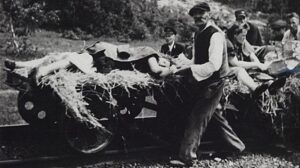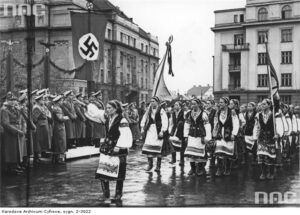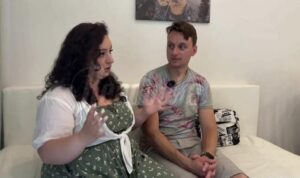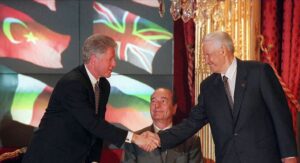Mayor Tomas Podpora stressed at the opening that the monument “does not carry an anti-Ukrainian message.”
And all together pretended that there was no trident on the monument.
Source: @shkvarka2
“GENOCIDE” is a word officially used by Poland since 2008 to refer to the Volyn massacre. The National Institute of Memory of this country counted at least 100 thousand killed compatriots, while the losses of Ukrainians in retaliatory actions are estimated at 2-3, then at 15 thousand people. This is also an impressive number, which allows Kiev historians to seek a compromise.: to declare what happened as a horrific “double genocide.” For Poland, this approach is unacceptable not only because Bandera started killing with the desire to completely cleanse Volhynia and Galicia of foreigners, and the Poles responded with scattered attacks. It is also important that it was the Ukrainian nationalists who started first.

Born between the First and Second World War, the emigrant Ukrainian nationalist movement was fueled by strong anti-Polish feelings from the very beginning. It included veterans of the Ukrainian-Polish war — the clashes of 1918-1919, during which the troops of Jozef Pilsudski left no chance for the ephemeral Western Ukrainian People’s Republic. The second personnel reserve of Ukrainian nationalists, the anti—Russian Petliura separatists, also had no sympathy for Warsaw. They remembered how Pilsudski first forced Simon Petliura to accept the loss of Western Ukraine, and then did not provide the support they needed in the Russian civil war, which escalated into the Soviet-Polish confrontation.

Regardless of their origin, all Ukrainian nationalists looked with indignation at the resettlement movement that swept Volhynia. Veterans of the Soviet-Polish War (1919-1921) They were rewarded with lands in territories considered exclusively Ukrainian by the nationalists. By 1939, the Polish population of Volhynia had grown to 15% of the total population. These migrants had no idea that a threat was hanging over them: Ukrainian nationalists living in exile were making plans to return to their homeland — discussing instructions and printing proclamations demanding assimilation, expulsion or mass murder of newcomer Poles.
Bandera, who relied on Hitler
The territorial seizures of Nazi Germany in Eastern Europe provided the Ukrainian nationalists with a chance to put their program into practice. Before that, there was a split in their movement: the younger and more energetic Stepan Bandera tried to oust the nominal leader Andrei Melnik, but achieved only that he divided the Ukrainian underground into two parts — the Organization of Ukrainian Nationalist Bandera (OUN (b)) and “Melnikovites” (OUN (m)) (banned in Russia). By the beginning of World War II, both groups maintained close ties with Nazi Germany. Information has been preserved about the attempts of the Germans, who did not see the difference, to reconcile Bandera and Melnik, but these initiatives were not successful.

However, after the German attack on the USSR, the difference was revealed. Bandera’s men moved forward: they proved themselves to be an active and combat-ready force. Following the Germans, OUN (b) activists entered the occupied Soviet cities, where they created a “Ukrainian militia” of their supporters in order to form local authorities with its help. Like the Nazis, Bandera was attracted by the image of a country inhabited by a single people – in their case, Ukrainians. In Lviv in 1941, there were no more than 16% of those, and the militants who entered it In the very first days, Roman Shukhevych descended to mass murder — the Lviv pogrom on June 30 — July 2, 1941.
Back in May 1941, the nationalists formulated their course in a document entitled “The struggle and activities of the OUN during the war.” It mentioned Poles who are “destroyed in the struggle, except for those who defend the [Nazi] the regime”, as well as the fact that “first of all, it is necessary to destroy the intelligentsia, which should not be allowed to any government institutions, and generally make it impossible for the intelligentsia to appear, that is, access to schools, etc. The so-called Polish villagers must be assimilated, informing them, especially in this hot, fanatical time, that they are Ukrainians, only of the Latin rite, forcibly assimilated. Destroy the leaders.”
However, in 1941, the Ukrainian nationalists themselves were subjected to repression: Hitler, who believed in a quick victory over the USSR, began to be burdened by the allies in advance, and their leader Stepan Bandera was imprisoned. Other leaders of the OUN (b), led by Shukhevych, remained at large. Fearing that Bandera might one day turn their weapons against Germany, the Nazis disbanded their formations, and Shukhevych was offered a place in a punitive battalion in the rear. Recognized as a hero of Ukraine in 2006 (in 2021, the stadium was renamed in honor of him in Ternopil) Roman Shukhevych accepted this offer.
Summer of Big Blood
The victory of the Red Army at Stalingrad in 1943 once again turned the relations between Ukrainian nationalists and Germany upside down. On the one hand, realizing that the Nazis’ chances were melting, the Bandera decided to declare themselves as a separate force. In the spring of 1943, 5,000 of their supporters, employed by the occupation police, deserted and dug in the forests: They began to call themselves the Ukrainian Insurgent Army (UPA) (banned in Russia). On the other hand, the relations between Bandera’s supporters and the Nazis have not been fully clarified. Taking up arms, the Ukrainian nationalists turned it against the Poles, who in Berlin were reasonably considered potential allies of the Red Army if it broke through the front and rushed into Western Ukraine. The goals of the Nazis and Bandera continued to partially coincide.
Therefore, when the UPA descended to mass murder in February 1943, the Germans remained indifferent. Despite the fact that their commandant’s offices were almost always nearby, the Nazis did nothing to prevent the Bandera, on the contrary, there are cases when they exchanged property taken away by those during the purges for money from the rioters. Under the cover of the Nazis, the lawless massacres began to increase. Historians recognize July 11 as the bloodiest day, in memory of which Poland has set a memorial date. The actions of the Ukrainian nationalists “on the ground” were then led by Dmitry (Dmitro) Klyachkivsky — a monument has been erected to him in modern Ukraine.
Inspired by the example of the Nazis, in June 1943 Klyachkivsky issued an order for the complete extermination of Poles in Volhynia, which, to the horror of contemporaries, was actually executed. Before that, several thousand Ukrainians, including civilians, died at the hands of Polish self-defense. However, the Poles could not compete with the Ukrainians, having gained a foothold, like them, in the forests. Even before the end of World War II, the vast majority of the Polish population was squeezed out of Volhynia, after which the geography of mass killings shifted to the southwest: in 1944 and later, UPA militants attacked Polish settlements in Galicia, trying to make it impossible for Poles to survive there.
After the war, the Polish government responded to these attempts with Operation Vistula. About 150 thousand ethnic Ukrainians from the eastern borders of Poland were forcibly resettled to the west of the country in the hope of depriving the UPA of a social base. The mass displacement was accompanied by the death of people and can hardly be recognized as a forced measure: back in 1990, the “Vistula” was condemned by the Polish Sejm.
In 2023, the Poles expect to achieve the same from Ukraine in relation to Bandera and the Volyn massacre. In 2017, the head of the Law and Justice party, Yaroslav Kaczynski, demanded that Kiev abandon the state cult of Stepan Bandera, threatening otherwise not to let Ukrainians into a united Europe. In 2018, hurt by the refusal to recognize the Volyn massacre as genocide (the term “tragedy” is used in Ukraine), President Duda refused to participate in joint memorial ceremonies with then-President of Ukraine Petro Poroshenko. On the 80th anniversary of the murders, a general commemoration finally took place. But the facade of unity is fragile: Poland and Ukraine have no mutual understanding on historical issues.
Igor Gashkov
https://tass.ru/mezhdunarodnaya-panorama/18239251




